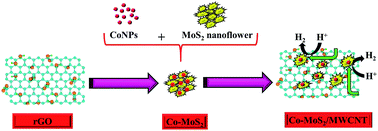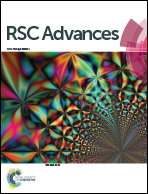Synergetic effect of CoNPs and graphene as cocatalysts for enhanced electrocatalytic hydrogen evolution activity of MoS2†
Abstract
Cobalt nanoparticles–molybdenum disulfide/reduced graphene oxide (Co–MoS2/rGO) composites have been successfully synthesized via a facile hydrothermal method for the first time. The synthesized composite consists of Co nanoparticles that uniformly anchored onto the surface of MoS2–graphene nanosheets. The nanohybrid was characterized by X-ray diffraction (XRD) patterns, Raman scattering, X-ray photoelectron spectroscopy (XPS) and transmission electron microscopy (TEM). Due to countless exposed active sites of the ultrathin MoS2 nanoflowers on the rGO, rapid ion diffusion and electron transport of the rGO with high strength and large specific surface area and reduction of hydrogen binding energy using CoNPs, the Co–MoS2/rGO composite showed superior electrocatalytic activity for hydrogen evolution reaction (Tafel slope of 50 mV dec−1, exchange current density of 2.9 × 10−2 mA cm−2 and onset potential values of 65 mV) compared with the pure MoS2 when used as electrode material. The turnover frequency per active site was calculated. This work demonstrates the feasibility of increasing HER activity of MoS2-based catalysts by combining MoS2 with rGO and Co noble metal nanoparticles.


 Please wait while we load your content...
Please wait while we load your content...